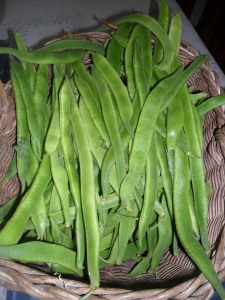Today I thought I would write about freezing our excess crops.
Last Friday I wrote about ‘Simple Living In The Modern day’. The freezer is a modern day appliance that makes life a lot easier for us, as we now have the luxury of being able to bulk buy, cook ahead, batch bake and preserve our excess crops (or bargains from the supermarket).
.
The first electric freezers were manufactured in 1945, but I remember it wasn’t until the 1970’s that my family had one. I remember at this time, ‘freezer centres’ sprung up all over the place. This revolutionised the way we preserve our food, as we can now store most crops in our freezers. In fact we have three freezers that are usually fit to busting at this time of the year.
The only two drawbacks with freezers after paying for the freezer in the first place, is they run on electricity, which costs money and if they lose power for long periods (i.e. in more rural areas in winter) the food inside will perish.
I find the amount I save by using my ‘A- rated’ freezers to preserve my crops, outweighs how much it costs to run them and I am lucky that we live in a town as so far we haven’t lost power for more than a few hours at any time.
.
In event of a power failure, a full freezer should stay frozen for up to 24 hours, provided you don’t open it to check, as warm air will speed up the thawing process. A half full freezer should stay frozen for up to 12 hours, but it’s important you check your own freezer manual.
.
.
Freezing is easy as most vegetables just need ‘blanching’ for a minute or two before freezing. I always thought that blanching increased the length of time you can store the produce (though I know not everyone blanches their vegetables before freezing and they seem to be fine). However, after researching this I have found the following on ‘Wiki Answers’:
“Blanching slows or stops the action of enzymes. Up until harvest time, enzymes cause vegetables to grow and mature. If vegetables are not blanched, or blanching is not long enough, the enzymes continue to be active during frozen storage causing off-colours, off-flavours and toughening.”
I have now learnt something new.
.
As regards to fruit, I never blanch my excess fruit and we have fruit all year round to add to yoghurts, ice-creams, pies etc. though it must be noted it does go soft and a bit mushy when it’s defrosted but it’s fine to eat. The only exception to this is apples as they go brown if you freeze them without blanching (though I have frozen bags of un-blanched crab apples, washed, top and tailed ready for crab apple jelly and they work fine).
.
How to blanch vegetables:
…Add your vegetables to a pan of boiling water and then bring the water back to boiling point again and then boil the vegetables for the recommended time (usually 1 or 2 minutes depending on size and particular vegetable). Drain the vegetables and immediately plunge them into very cold water, to stop the cooking process.
(I have a freezer book that tells me how long to blanch each vegetable for, but you can find the recommended blanching times on the internet these days).
.
What Is Open Freezing?
This is a way to stop all the vegetables in a freezer bag from sticking together in one great big lump, so it’s easy to remove a few at a time e.g. a portion of peas when you need them.
When you have blanched your vegetables, lay them on a tray and freeze them. When they are frozen, remove them from the tray and pop them into a freezer bag/container and put them back into your freezer.
.
.
A Few Of My Top Tips For Freezing Fruit And Vegetables:
.
Nearly every fruit and vegetable can be frozen in some way or another, it’s just a matter of finding out what works best for you.
.
- Courgettes can be frozen ready sliced, by open freezing them and then bagged up ready to add to spaghetti bolognaise, pasta sauces etc. or they can be grated and bagged up in 340g bags, ready to add to cheesy courgette scones.
- Tomatoes can be frozen in bags (without blanching), ready to make tomato soup at a later day. I just wash them and chop them in half and bag them up in the weight required for your recipe.
- Tomatoes can also be cooked with a little bit of water and then ‘blitz’ with a liquidizer to make a tomato sauce to use in pasta sauces, spag bogs etc. instead of using shop bought passata. I freeze this in ready weighed out portions of 500 grams and I just defrost it before using.
- I find pumpkin is better to cook first and freeze in bags ready weighed out. This way it can be added to soups and cakes etc. and it takes up far less room.
.
When I need to dig up my winter crops (i.e. my leeks and parsnips) to prepare the soil for my next crops, I freeze them:
- I wash and slice up my leeks and bag them up (again in useable quantities) and then freeze them. Leeks and onions can make other things in your freezer smell, so I do wrap them up well in newspaper first, to prevent this.
- I wash and peel my parsnips and cut them ready for ‘roasting’. I then open freeze them, without blanching and then pop them into a freezer bag. They are great to use straight from frozen and make Sunday lunch easier to cook.
- I also quite often freeze excess fruit the day I pick it (e.g. Strawberries, gooseberries, currants, plums, rhubarb etc.). I use the fruit to make jam when I have more time in the winter, by adding the frozen fruit straight into the pan.
- Sweet corn is delicious when it has been picked and eaten within the hour. I blanch my sweet corn whole and freeze it in bags of four or five corn on the cobs. It is lovely to eat this in the depths of winter.
- I Trim off the leaves of parsley and wash them. I put the lot in a freezer bag and freeze. I use it from frozen by crumbling it into my meals as I cook them.
- Just before my Jerusalem artichokes start to sprout in March/April time, I freeze them. I wash and cut them ready for ‘roasting’. I open freeze them, without blanching and then pop them into a freezer bag. They are great to use straight from frozen and again they make Sunday lunch easier to cook.
- I slice my cooked beetroot and open freeze and then pop it into bags ready for use. This gives an alternative to pickled beetroot and can also be used in a chocolate beetroot cake.
- I use my freezer to freeze individual plastic bottles of apple juice that I press myself. It’s easy to pop a bottle in my daughters lunchbox in the morning and it defrosts by lunchtime, keeping her lunch box cold until then:
.
I can honestly say the only fruit or vegetables I haven’t frozen in some way or another is cucumbers and lettuce as they don’t freeze very well. Although cucmbers and lettuce can be used in a gardener’s soup, which so far I haven’t tried to make yet, but with the amount of cucumbers I picked yesterday, I may just have a go!
.
I couldn’t be without our freezers as they make my life so much easier to store my excess produce. I wonder if anyone reading this has any top tips for freezing excess fruit and vegetables too? If so I would love you to hear from you.
On Monday I will be writing my usual monthly post ‘What to do in the kitchen garden in September’ and I will follow this next Friday with ‘Preserving And Storing Our Crops – Part 3’.
Thank you for reading my blog today.
I will be back again on Monday at the usual time.




































































































































































